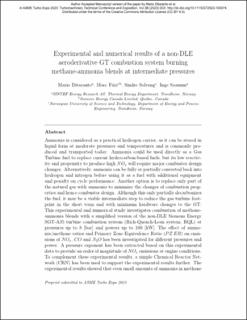| dc.contributor.author | Ditaranto, Mario | |
| dc.contributor.author | Füri, Marc | |
| dc.contributor.author | Solvang, Sindre Ertzgaard | |
| dc.contributor.author | Saanum, Inge | |
| dc.date.accessioned | 2024-02-05T08:20:28Z | |
| dc.date.available | 2024-02-05T08:20:28Z | |
| dc.date.created | 2023-11-30T10:40:19Z | |
| dc.date.issued | 2023 | |
| dc.identifier.citation | Proceedings of ASME Turbo Expo 2023 Turbomachinery Technical Conference and Exposition | en_US |
| dc.identifier.isbn | 978-0-7918-8696-0 | |
| dc.identifier.uri | https://hdl.handle.net/11250/3115431 | |
| dc.description.abstract | Ammonia is considered as a practical hydrogen carrier, as it can be stored in liquid form at moderate pressures and temperatures and is commonly produced and transported today. Ammonia could be used directly as a Gas Turbine fuel to replace current hydrocarbon-based fuels, but its low reactivity and propensity to produce high NOx will require major combustor design changes. Alternatively, ammonia can be fully or partially converted back into hydrogen and nitrogen before using it as a fuel with additional equipment and penalty on cycle performance. Another option is to replace only part of the natural gas with ammonia to minimize the changes of combustion properties and hence combustor design. Although this only partially decarbonizes the fuel, it may be a viable intermediate step to reduce the gas turbine footprint in the short term and with minimum hardware changes to the GT. This experimental and numerical study investigates combustion of methane-ammonia blends with a simplified version of the non-DLE Siemens Energy SGT-A35 turbine combustion system (Rich-Quench-Lean system, RQL) at pressures up to 8 [bar] and powers up to 100 [kW]. The effect of ammonia/methane ratios and Primary Zone Equivalence Ratio (PZER) on emissions of NOx, CO and N2O has been investigated for different pressures and power. A pressure exponent has been extracted based on this experimental data to provide an order of magnitude of NOx emissions at engine conditions. To complement these experimental results, a simple Chemical Reactor Network (CRN) has been used to support the experimental results further. The experimental results showed that even small amounts of ammonia in methane result in unacceptably high NOx emissions for all Primary Zone temperatures and pressures investigated. Although increasing pressure reduces NOx emissions (as previously reported), extrapolation to engine conditions showed that the order of magnitude of NOx emissions will remain unacceptably high. It is also shown that flame stability becomes insufficient for fuels containing more than 40–50 [% by vol.] of NH3 as blow out occurred for these fuels. Furthermore, the results showed that N2O emissions are very low for rich Primary Zone Equivalence Ratios and increase approximately exponentially with decreasing equivalence ratios, but remained below 10 [ppm] for cases at higher pressures. Finally, the CRN results reproduced the experimental trends qualitatively well for %NH3 variations but PZ ER variations and absolute values could not be matched for all cases simultaneously without re-tuning of the CRN. | en_US |
| dc.description.abstract | Experimental and Numerical Results of a Non-DLE Aeroderivative GT Combustion System Burning Methane-Ammonia Blends at Intermediate Pressures | en_US |
| dc.language.iso | eng | en_US |
| dc.publisher | ASME | en_US |
| dc.relation.ispartof | ASME Turbo Expo 2023: Turbomachinery Technical Conference and Exposition - Volume 3B: Combustion, Fuels, and Emissions | |
| dc.rights | Navngivelse 4.0 Internasjonal | * |
| dc.rights.uri | http://creativecommons.org/licenses/by/4.0/deed.no | * |
| dc.title | Experimental and Numerical Results of a Non-DLE Aeroderivative GT Combustion System Burning Methane-Ammonia Blends at Intermediate Pressures | en_US |
| dc.title.alternative | Experimental and Numerical Results of a Non-DLE Aeroderivative GT Combustion System Burning Methane-Ammonia Blends at Intermediate Pressures | en_US |
| dc.type | Chapter | en_US |
| dc.type | Peer reviewed | en_US |
| dc.description.version | acceptedVersion | en_US |
| dc.rights.holder | The Authors hold the copyright to the Author Accepted Manuscript. Distributed under the terms of the Creative Commons Attribution License (CC BY 4.0) | en_US |
| dc.identifier.cristin | 2206164 | |
| dc.relation.project | Norges forskningsråd: 296207 | en_US |
| dc.source.articlenumber | GT2023-103074 | en_US |
| cristin.ispublished | true | |
| cristin.fulltext | postprint | |
| cristin.qualitycode | 1 | |

